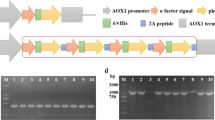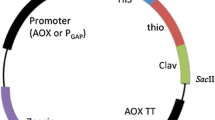Abstract
Perinerin, an antimicrobial peptide (GenBank No. P84117), was isolated and characterized from Asian marine clamworms, Perinereis aibuhitensis Grube. This peptide has effects against both gram-positive and gram-negative bacteria in vitro, especially on Pseudemonas aeruginosa. In our study, bioactive perinerin was expressed in Pichia pastoris, and characterized its physicochemical properties. The expressed sample was firstly analyzed by Tricine-SDS-PAGE, after then the recombinant proteins were purified by 2 kD MW cut-off (MWCO) ultrafiltration membrane, and finally purified by 10 kD MWCO ultrafiltration membrane and CM 52-ion exchange chromatography. About 6% protein was obtained by this so called three-purification method. Our results showed that Pichia pastoris was a suitable system for secreting perinerin. Bioactivity assay proved that the recombinant perinerin had antimicrobial effects.



Similar content being viewed by others
References
Almeida MS, Cabral KS, Medeiros LN et al (2001) cDNA cloning and heterologous expression of functional cysteine-rich antifungal protein Psd1 in the yeast Pichia pastoris. Arch Biochem Biophys 395:199–207
Bachere E, Gueguen Y, Gonzalez M et al (2004) Insights into the antimicrobial defense of marine invertebrates: the penaeid shrimps and the oyster Crassostrea gigas. Immunol Rev 198:149–168
Braff MH, Gallo RL (2006) Antimicrobial peptides: an essential component of the skin defensive barrier. Curr Top Microbiol Immunol 306:91–110
De Smet K, Contreras R (2005) Human antimicrobial peptides: defensins, cathelicidins and histatins. Biotechnol Lett 27(18):1337–1347
Firoozkoohi J, Zandi H, Olsen I (1997) Comparison of lipopolysaccharides from Bacteroides, Porphyromonas, Prevotella, Campylobacter and Wolinella spp. by tricine-SDS-PAGE. Endod Dent Traumatol 13:13–18
Hancock REW (1997) Peptide antibiotics. Lancet 349:418–422
Horton RM, Cai ZL, Ho SN et al (1990) Gene splicing by overlap extension: tailor-made genes using the polymerase chain reaction. Biotechniques 8:528–535
Ito K, Ishimaru T, Kimura F et al (2007) Importance of N-glycosylation positioning for secretion and folding of ovalbumin. Biochem Biophys Res Commun 361(3):725–731
Koczulla AR, Bal R (2003) Antimicrobial peptides: current status and therapeutic potential. Drugs 63:389–406
Koganesawa N, Aizawa T, Masaki K et al (2001) Construction of an expression system of insect lysozyme lacking thermal stability: the effect of selection of signal sequence on level of expression in the Pichia pastoris expression system. Protein Eng 14:705–710
Liu ZM, Lu ZX, LV FX et al (2006) Heterologous expression and purification of protopectinase-N from Bacillus subtilis in Pichia pastoris. Process Biochem 41:975–979
Masuda T, Ueno Y, Kitabatake N (2005) High yield secretion of the sweet-tasting protein lysozyme from the yeast Pichia pastoris. Protein Expr Purif 39:35–42
Oliveira DG, Toyama MH, Novello JC et al (2002) Structural and functional characterization of basic PLA2 isolated from Crotalus durissus terrificus venom. J Protein Chem 21:161–168
Pan WD, Liu XH, Ge F et al (2004) Perinerin, a novel antimicrobial peptide purified from the clamworm Perinereis aibuhitensis Grube and its partial characterization. J Biochem 135:297–304
Patrzykat A, Douglas SE (2003) Gone gene fishing: how to catch novel marine antimicrobials. Trends Biotechnol 21:362–369
Porcelli F, Verardi R, Shi L et al (2008) NMR structure of the cathelicidin-derived human antimicrobial peptide LL-37 in dodecylphosphocholine micelles. Biochemistry 47(20):5565–5572
Singh MB, Bhalla PL (2006) Recombinant expression systems for allergen vaccines. Inflamm Allergy Drug Targets 5:53–59
Wu S, Letchworth GJ (2004) High efficiency transformation by electroporation of Pichia pastoris pretreated with lithium acetate and dithiothreitol. Biotechniques 36:152–154
Xia HC, Li F, Li Z et al (2003) Purification and characterization of Moschatin, a novel type Iribosome-inactivating protein from the mature seeds of pumpkin (Cucurbita moschata), and preparation of its immunotoxin against human melanoma cells. Cell Res 13:369–374
Yoshimasu MA, Tanaka T, Ahn JK et al (2004) Effect of N-linked glycosylation on the aspartic proteinase porcine pepsin expressed from Pichia pastoris. Glycobiology 14(5):417–429
Zhang J, Zhang SQ, Wu X et al (2006) Expression and characterization of antimicrobial peptide ABP-CM4 in methylotrophic yeast Pichia pastoris. Process Biochem 41:251–256
Zhou QF, Luo XG, Ye L et al (2007) High-level production of a novel antimicrobial peptide perinerin in Escherichia coli by fusion expression. Curr Microbiol 54(5):366–370
Acknowledgments
The authors are deeply grateful to Dr Liangzhu Wen for affording the pPIC9K vector and host bacteria Pichia pastoris. They express thanks to Dr Yunhua Lu’s helpful comments for experiment design.
Author information
Authors and Affiliations
Corresponding author
Rights and permissions
About this article
Cite this article
Zhou, Q., Li, M. & Xi, T. Cloning and Expression of a Clamworm Antimicrobial Peptide Perinerin in Pichia pastoris . Curr Microbiol 58, 384–388 (2009). https://doi.org/10.1007/s00284-009-9372-4
Received:
Revised:
Accepted:
Published:
Issue Date:
DOI: https://doi.org/10.1007/s00284-009-9372-4




